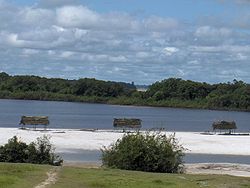| Atabapo River | |
|---|---|
 | |
 | |
| Location | |
| Countries | |
| Physical characteristics | |
| Length | 280 km (170 mi) |
| Basin size | 13,000 km2 (5,000 sq mi) |
| Discharge | |
| • average | 883 m3/s (31,200 cu ft/s) |
Atabapo River is a river of Venezuela and Colombia. It forms the international boundary between the two countries for much of its length. It is part of the Orinoco River basin.
